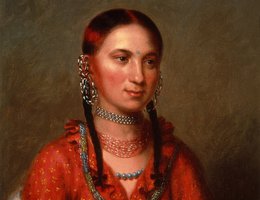
The Oto tribe gave this state its name, but they were not native to the region. "Nebraska" is an Oto word that means "flat water." Like migrant groups before and after, the Oto immigrated to the Central Plains from the east, just ahead of the Europeans.

The earliest mention of the Oto and Missouria tribes in the European historical record dates from the late 1600s. The Missouria were then in central Missouri and the Oto were in central Iowa. The Otos evidently moved to the lower Platte River valley and established villages such as the Eagle Ridge and the Ashland (or Patterson) sites by the first decades of the 1700s. The precise reasons for the migration are unclear, but the ever-increasing European colonial activity in the east probably motivated the tribes to move west.
So, the principal Siouan people in Nebraska in the first half of the 1700s were the Omaha and Ponca in northeast Nebraska and the Oto in the lower Platte River valley of Nebraska. Despite the fact that they spoke a similar language as the Sioux tribes to the west, these were very different groups of people. The western Sioux tribes, like the Lakota Sioux, were nomadic, moving from place to place hunting bison. The Oto lived in permanent villages in the east and always returned from their semi-annual hunts to these villages.
After they migrated to this area, the Omaha, Ponca, and Oto were immediately in contact with Caddoan speaking tribes such like the Pawnee. The details of these interactions are unclear, and Native American accounts refer to some conflict between tribes. Yet, it’s doubtful there was ever an all-out war.
The relatively peaceful co-existence of Caddoan and Siouan people in eastern Nebraska during the 1700s and early 1800s is probably linked to European and American colonial activities. Initially, native people were probably curious about what the few Europeans who ventured into the plains had to offer. In fact, the Pawnee and Oto began to cooperate with each other in dealing with colonial interests, and that was beneficial to both tribes.
The Oto had closer access (direct or indirect) to French and English trade goods in this early contact phase. They may have presented themselves as the primary conduit for trading these commodities to the Pawnee. The Otos were also a reliable source of catlinite for the Pawnee. Catlinite was used by the Pawnee to carve tobacco pipes. The Oto could trade catlinite because they used to live in the Pipestone, Minnesota, region where catlinite is plentiful. Some finished catlinite artifacts occur on Pawnee sites, but they are not common. Both finished artifacts and abundant manufacturing debris is common on Siouan sites such as Eagle Ridge. If the Pawnee were receiving trade goods and catlinite from tribes like the Oto, what were the Pawnee offering in return? The Pawnee controlled a vast region abundant in bison and may have been offering bison products or direct access to hunting ranges to the Sioux.
As Europeans ventured forth, they thought it was important to form alliances with indigenous tribes. The Spanish, French and English all wanted access to furs and hides that were abundant on the plains. The Pawnee and Oto worked together so they could provide Europeans with beaver and other pelts as well as bison robes in exchange for trade goods.
Archaeological evidence indicates the Siouans rapidly adopted Pawnee culture rather than the other way around. Oneota pottery is only occasionally found at Pawnee sites, but numerous shell-tempered pots with Pawnee form and design are recovered from the Eagle Ridge site.
At one point, the Missouria was a large tribe, but early contacts with white traders brought diseases for which they had no immunity. Small pox, whooping-cough, and other new illnesses decimated the tribe. By 1800, there may have been no more than 100 people left, and they joined the Oto for protection.
The Oto had moved out of Iowa and were living in an earth lodge village on the Platte River not far from its juncture with the Missouri, near present-day Plattsmouth. The earth lodge became the standard house type for the Omaha and Oto by the late 1700s and perhaps earlier. Adoption of the earth lodge by the Oto was likely a practical matter. This house form is much better suited to the harsher Plains climate than were traditional bark or grass-covered homes.
The Oto and Missouria eventually were forced to accept a reservation in Gage County, Nebraska, in 1854. By 1881 white settlers were able to acquire the reservation land and the Oto and Missouria were sent to a reservation in Oklahoma.